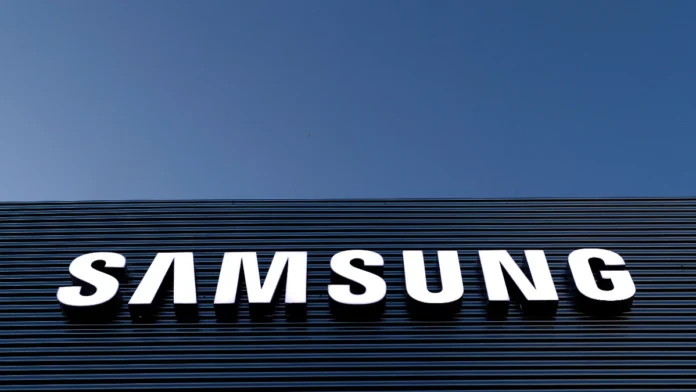Samsung Electronics Co. has witnessed an unexpected and monumental market downturn, wiping out $122 billion in its value as the company struggles to maintain its footing in the fast-evolving AI sector. Once poised to reap the rewards of the global AI boom, Samsung has found itself trailing behind competitors in AI-focused memory and chip technology. Now, with investor confidence shaken and international markets losing faith, Samsung’s future in a highly competitive tech landscape is increasingly uncertain.

Why Samsung’s AI Market Position Matters
For decades, Samsung has been a global tech powerhouse, with strongholds in consumer electronics, semiconductors, and smartphones. However, the rise of artificial intelligence has transformed the semiconductor industry, with demand for high-bandwidth memory (HBM) and advanced chipsets that support AI processing at unprecedented levels. As Samsung’s competitors, including SK Hynix and Taiwan Semiconductor Manufacturing Co. (TSMC), have aggressively pushed forward with AI-enhanced memory and chip production, Samsung has struggled to keep pace.

Samsung’s dependence on its semiconductor business has only amplified the impact of these challenges. While consumer electronics, particularly smartphones, remain a key segment, semiconductors have been the company’s largest profit driver. The slump in Samsung’s AI-enabled memory offerings has dealt a heavy blow to investor confidence, evidenced by the 32% drop in Samsung shares since July 9. The setback underscores just how critical AI-focused innovation is for today’s tech companies—and how costly it can be for those who fall behind.
What Led to Samsung’s $122 Billion Market Loss?
Several factors have contributed to Samsung’s steep market decline. As investor concerns over Samsung’s competitive edge in AI tech grew, shares began a downward spiral. In addition, rivals such as SK Hynix have accelerated their own advancements in AI memory, with SK Hynix reaching volume production of its latest-generation HBM chips just as Samsung reported delays. The gap between Samsung and its competitors became painfully clear, particularly as US-based Micron Technology ramped up its HBM capabilities in response to soaring demand.

Furthermore, Samsung’s delays in high-bandwidth memory production have dashed investor hopes that it could close the gap with leaders like Nvidia, which has redefined AI processing with its advanced processors and HBM technology. This combination of production delays, competition, and waning investor confidence culminated in Samsung’s staggering $122 billion market value wipeout.
How Samsung Plans to Address Its AI Competitiveness
In response to this substantial setback, Samsung has announced a strategy overhaul aimed at revamping its competitiveness in the AI and semiconductor sectors. Yet, international investment firms such as Pictet Asset Management Ltd. and Janus Henderson Investors SP Ltd. remain skeptical about the effectiveness of Samsung’s proposed changes. Since late July, overseas investors have sold off a significant $10.7 billion worth of Samsung shares, indicating deep-seated doubts about the company’s ability to reverse course in the near term.
Sat Duhra, a portfolio manager at Janus Henderson Investors SP in Singapore, noted the firm’s reduced stake in Samsung, which was once its largest position. Although the stock’s valuation has become more attractive with recent price drops, Duhra emphasized the firm has “no intention” of reinvesting until clearer signs of a turnaround emerge.
Samsung’s Current Challenges in the Semiconductor Market
The broader story of Samsung’s challenges mirrors shifts in the semiconductor industry, where AI has become the defining force. Despite its dominant position in consumer electronics, Samsung has failed to secure a solid lead in AI-related chip technology. The company’s October apology to investors for disappointing results underscores the magnitude of its current difficulties. While Samsung’s legacy products—such as smartphones—remain steady revenue drivers, the company has yet to fully capitalize on the lucrative AI chip market, now dominated by players like Nvidia, TSMC, and SK Hynix.
Recent months have seen Samsung attempt to address its lag in the AI chip race by exploring strategic partnerships and in-house advancements. Nevertheless, the production delays and the release of Samsung’s HBM chips well behind its competitors have sparked a critical reassessment of the company’s position in the global semiconductor hierarchy.
The Role of International Competitors and the Growing AI Demand
The global AI market’s expansion has elevated competition among tech giants, with major companies racing to develop and deliver more advanced, AI-specific memory solutions. Samsung, facing challenges from both regional and international competitors, has struggled to keep pace with this demand. SK Hynix has emerged as a significant player in the AI memory sector, and US-based Micron Technology is also strengthening its position, propelled by growing interest in AI-driven solutions worldwide.
The semiconductor market is now shaped by innovations that support AI processing, including advancements in high-bandwidth memory. As Samsung grapples with delays and production issues, its competitors have capitalized on these opportunities, fulfilling the demands of AI-focused enterprises and governments investing heavily in tech infrastructure.
How Samsung’s Market Loss Impacts Its Reputation and Strategy
Samsung’s market drop not only affects its valuation but also its brand reputation as a tech leader. The decline highlights how the AI boom is not just a passing trend but a seismic shift affecting long-standing players in the industry. For Samsung, this means rethinking its approach to technology development and adapting to a market where AI is no longer an optional frontier but a core competitive factor.
While Samsung’s response to these setbacks includes promises of internal restructuring and increased investment in AI, its investors and market observers remain cautious. The company’s ability to adapt will be crucial as it seeks to re-establish itself as a leader in AI memory and chip production—a move that will require significant time, resources, and innovation.
Conclusion: Can Samsung Regain Its Position?
The sharp drop in Samsung’s market value following its struggles with AI technology reflects the high stakes of today’s tech industry. With a market increasingly driven by AI applications, companies that fail to innovate risk being left behind. Samsung’s delayed response to the demand for AI memory solutions has cost it dearly, both in financial terms and investor confidence. However, the company’s plans for an overhaul offer a potential pathway to recovery.
Samsung’s future now hinges on its ability to make meaningful strides in AI-focused memory and semiconductor technology. If the company can capitalize on its existing strengths and address production delays, it may yet reclaim its place in the rapidly evolving AI-driven tech landscape. But for now, Samsung’s experience serves as a cautionary tale of the cost of missing out on a transformative trend—and a reminder that in the world of tech, staying ahead requires constant adaptation and innovation.

